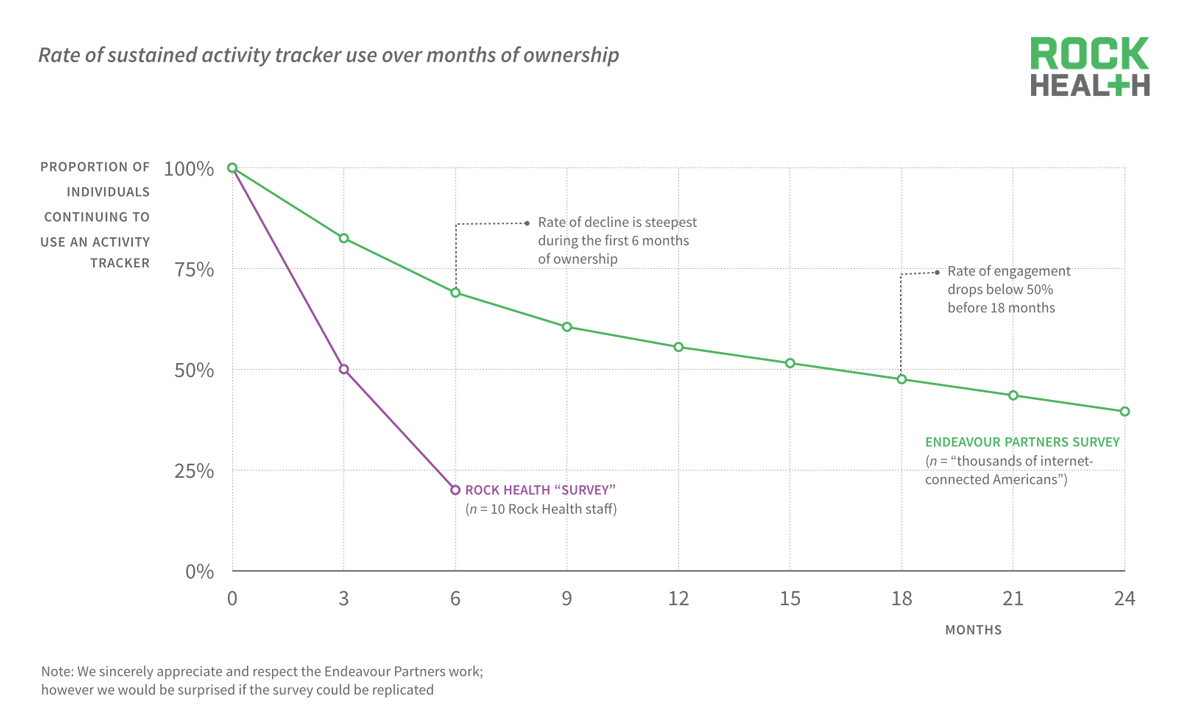The push for value based healthcare – higher quality, better access, and lower cost – has opened up the door for technology to automate elements of care at a much lower cost. In the last few years, there has been a proliferation of mobile applications in the healthcare space – evidenced by the more than 165,000 health apps available in the app stores (1). However, there is a key trend appearing: It is one thing for the technology to be available, but in order for it to be effective, sustained usage by patients is key. According to Accenture (2), “hospitals have only engaged 2% of their population using mobile apps”.
Engagement is a key metric to determine if mobile technologies are being used effectively. Localytics measures engagement as the percentage of an app’s users who have over 10 sessions a month (3). Across all types of apps, not just healthcare, engagement was measured at 31% (4). In healthcare, engagement tends to be high after the initial download of an app or purchase of a device, but starts to drop off over time, as evidence by the chart below that documents the use of an activity tracker:

Ultimately, if healthcare apps and digital health companies want to be effective, it must also have sustained engagement, meaning it can command high engagement over a long period of time. If a healthcare provider is relying on a diabetes app to manage a patient’s chronic condition, it would be essential for the app to be used over a long period of time to be deemed effective.
Here are 5 key takeaways on how to create a long-term sustained patient engagement strategy for a healthcare technology platform and yield better outcomes:
- Know your audience
We all know that a 21-year-old girl and a 65-year-old man are very different, and likely have very different behaviors around technology. The Pew Research Center looked at smartphone ownership in the U.S. and found that only 42% of people over the age of 65 own a smartphone, but when you look at the demographic between 18 – 29, that rate jumps to 92% .(5)
Unfortunately, many apps assume everyone is the same. Create a risk-based care plan based on the patient profile. The experience of a first-time user like a clinically low-risk patient who lives in a metropolitan area will be different than a patient who lives in a high-risk, rural area. Risk-based experiences promote higher engagement and compliance to a platform.
- Screen your users
Technology is not a silver bullet. There is a cohort of the population that will NEVER use a mobile application. By using a risk-assessment screening on the front end, you can figure out who these users are early and either modify the way they are managed, or simply recommend that they are not a candidate for the application. Risk screenings also can collect a lot of information about a user on the front end – preferred mode of communication (i.e. email, in-app messaging or push notification) or ideal time of app use (i.e. morning or evening). If these preferences are then built into the apps’ way of managing the patient, the engagement scores will reflect it! Always remember that technology can only amplify care plans and enable patients, not solve clinical diagnoses.
- In healthcare, don’t forget the care team
Unlike almost every other industry, in healthcare the consumer does not make the decision entirely by themselves. In fact, we as consumers in most instances defer this decision to trusted third parties —> providers of care. An app that a medical provider uses and personalizes for his patients with their specific needs is one that is more likely to be used by the patient. The provider can then use this as a tool to communicate important information specific to the patient. According to IMS health, the sustain rate from “prescribed apps” is much higher than consumer apps – over 45%!
- IoT is real
Adding in internet connected devices is a great way to keep engagement high. Almost all medical devices have the capability to connect to the internet – either through WiFi, Bluetooth or cellular connection. Adding in an internet connected glucometer, for example, gives a patient a tool to collect data about his own health, and ensures that he logs into the app to access the data to be more informed. Accenture published a report on patient engagement and found that 77% of consumers and 85 % of providers believe that the use of a wearable health device helps with engagement in one’s own health (6).
We are now entering a world where the phone isn’t the only thing that is smart. Smart speakers, smart cars, smart light bulbs and smart watches are very quickly becoming the norm. Knowing that the phone is not the only way to get to the users, is a key insight. Weather it’s an Alexa plugin or something for a VR headset know what drives engagement.
- Collect data…and then keep collecting, then keep collecting some more data
Some say ‘Data is King’, but data doesn’t always translate into value. The goal is to collect, collect, collect, and then leverage clinical expertise and third party resources to see what is valuable over time. We also believe that collaborating with others who have adjacent data can be extremely powerful. One recent example is a study that was just published in the New England Journal of Medicine around genes and preterm birth. The company 23andMe collaborated with the March of Dimes Prematurity Center to share genetic data collected across populations to determine if there was a correlation between preterm birth and genetics. (7)
- Always iterate and learn
This one’s a no brainer, you will be surprised to see a lot companies with some early initial success miss this point. Technology should never remain stagnant. Just because something works well today, doesn’t mean it will work well tomorrow. Human behavior is also constantly changing, particularly around technology. Keep up with these changes by continually iterating on the platform that you have built, and leverage A/B testing across users to see how you can do something better tomorrow.
These themes should make for a product that not only engages patients, but allows for sustained engagement which ultimately will empower users to move toward better outcomes.
References
- http://www.healthcareitnews.com/news/how-many-health-apps-actually-matter
- 2015 Accenture Report, https://www.accenture.com/us-en/insight-health-losing-patience.aspx
- Localytics https://www.localytics.com/resources/app-stickiness-index-q3-q4-2015/
- Localyticshttp://info.localytics.com/blog/mobile-apps-whats-a-good-retention-rate
- http://www.pewinternet.org/fact-sheet/mobile/
- https://www.accenture.com/t20160629T045303__w__/us-en/_acnmedia/PDF-6/Accenture-Patients-Want-A-Heavy-Dose-of-Digital-Research.pdf
- NEJM “Genetic Associations with Gestational Duration and Spontaneous Preterm Birth” http://www.nejm.org/doi/full/10.1056/NEJMoa1612665
About the authors
 Anish Sebastian, Co-Founder & CEO, Birthscripts
Anish Sebastian, Co-Founder & CEO, Birthscripts
 Dr. Nihar Ganju, Co-Founder & CEO,Advantia Health
Dr. Nihar Ganju, Co-Founder & CEO,Advantia Health












